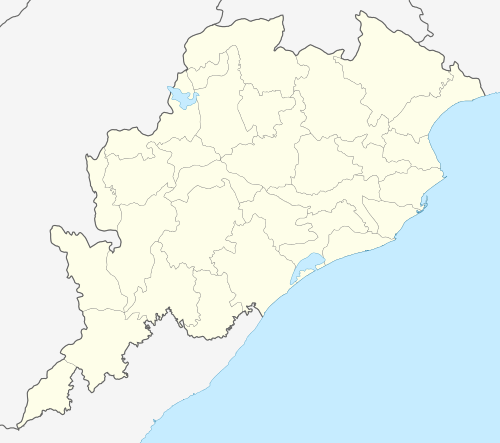Sisua village
| Sisua ଶିଶୁଆ | |
|---|---|
| Village | |
 Sisua Location in Orissa, India | |
| Coordinates: 20°28′45″N 86°04′56″E / 20.479063°N 86.082268°ECoordinates: 20°28′45″N 86°04′56″E / 20.479063°N 86.082268°E | |
| Country |
|
| State | Orissa |
| District | Cuttack |
| Population | |
| • Total | 983 |
| Languages | |
| • Official | Oriya |
| Time zone | IST (UTC+5:30) |
| PIN | 754202 |
| Telephone code | 0671 |
| Vehicle registration | OD- |
| Nearest city | Cuttack |
Sisua (Odia: ଶିଶୁଆ) is a village in the Salepur block of Cuttack district, in the state of Odisha (previously called Orissa[1]), India. The village consists of approximately 200 dwellings.[2][3] The village can be reached by rail; however, the nearest rail station, Cuttack Rail Way Station, is 16 km from Sisua.[4] Situated at the village entrance is a huge Jagannath temple. There is a small pond near the Jagannath temple filled with lots of fish and lotuses. An annual cart festival is organized by the villagers.
People celebrate Raja, Ratha Yatra, Pana Sankranti, Dola, Holi and Diwali every year. There is also a huge festival organized by local politicians every year on April 1, where thousand of people gather to celebrate. Thousands of shops and stalls contribute to the beauty of this festival, with a fireworks competition as a key feature. The main economic activity is agriculture; rice and lentils such as mung/moong and peanuts are among the more important crops.
There are three schools in Sisua; the Govt. Approved U.P. School - Sisua,[5] and two private schools, Utkalmani Sisusikshya Mandir, and Saraswati Sishu Mandir.[6]
Demographics
Sisua village is the home of 1214 people (626 males (52%), and 588 females (48%)). 78% of the population are general caste, 20% are schedule caste and 2% are schedule tribes. Children under the age of 6 represent only 10% of the population of the village (51% boys and 49% girls). There are about 254 households in the village, with an average of 5 individuals per household.[7]
Food
Oriya foods include rice, tomatoes, potatoes, dal like mung, peanuts, vegetables similar to yam, bitter gourd (called Momordica charantia), Dillenia Speciosa, pumpkin, white gourd (winter melon), red gourd, spinach in their roof and sweet potato, Trichosanthes cucumerina, Luffa, okra, cauliflowers, cabbages, eggplants and arum can be found in an Oriya family's backyard.
One dish, Pakhala, made from a mix of boiled rice and water, is eaten with boiled potatoes mixed with green chili pepper, curd, salt, and onions.[8] Biri chaula chakuli pithaconsisting of Vigna mungo and rice. It is normally eaten for breakfast. Chakuli pitha can be eaten with Santula or Dalma. Pitha is the main sweet dish at every festival they celebrate. There are different types of pitha made out of rice like Aarisa pitha, Manda Pitha, Kakara Pitha, Enduri Pitha, Chakuli Pitha, Poda Pitha, Chitau Pitha, Tala Pitha and much more.[9]
Festivals
Many festivals are celebrated in this village, such as Manabasa Gurubara,[10] Raja, Dasahara, Holi, Diwali and Dola festival. Manabasa Gurubara is the biggest festival celebrated in this village because the religion of the locals is Hindu. Manabasa Gurubara is celebrated for the goddess of Laxmi, the deity of wealth and prosperity. This festival is celebrated each Thursday in the month of Margasira, which is four times during the month. Women clean their houses and make jhoti chita[11] from rice paste. It is believed that Laxmi visits each home on these days and gives blessings. There is a story about this festival in Laxmi Puran.
Raja (festival),[12] another popular festival in this village, is for girls only. During this festival, girls wear new dresses, eat all types of pitha, and visit their friends and relatives.
Dola festival[13] is another festival celebrated by villagers on the day of Holi, and is similar to the better-known festival. Lord Krishna comes to everyone's home on a wooden cart and plays with Abira and colour. Abira is similar in colour but it is natural and made from dry leaves and sands. Lord Krishna offers new mangoes, and these are the first mangoes that appear on the mango trees.
Sports
There is a cricket ground[14] in the village where children can play cricket and other types of games, such as marbles, Kabaddi, and Gilli-danda. Sisua people also organize cricket tournaments every year to encourage excitement for the sport.
See also
References
- ↑ "Orissa's new name is Odisha - Times of India". Retrieved 2016-07-10.
- ↑ "Sisua Village Population - Salepur - Cuttack, Orissa". www.census2011.co.in. Retrieved 27 June 2016.
- ↑ "Map of Sisua Village". Indian map. Retrieved 19 April 2016.
- ↑ "About Sisua". onefivenine explore India. Retrieved 27 June 2016.
- ↑ "Sisua Panchayat Salepur Block CUTTACK District Odisha orissa India". naveenpatnaik.com.
- ↑ "Utkalmani Sisusikshya Mandir School, Sisua, Salipur". freetutorial.in.
- ↑ "Sisua Village Demographics". Retrieved 27 June 2016.
- ↑ "Odiya Summer Dish – Pakhala, Saga Bhaja, Badi Chura, Macha Bhaja". www.therecipebucket.com. sarita. Retrieved 19 October 2016.
- ↑ "Pitha - Authentic Odia Cuisines & Recipes". www.odiakitchen.com. Retrieved 19 October 2016.
- ↑ "Manabasa Gurubara" (PDF).
- ↑ "Jhoti or Chita". D'Source. Retrieved 25 April 2016.
- ↑ Banaste Dakila Gaja Barasake thare asichi Rajo Asichi Rajo lo heba nua saja bajja…… (Rajo Geeta). "odisha.gov.in" (PDF). Retrieved 2 May 2016.
- ↑ Sogani,www.aryabhatt.com, Gunjan. "Festivals of India - DOLA PURNIMA-HOLI". www.aryabhatt.com. Retrieved 2016-11-30.
- ↑ Satish, Behera. "Sisua Village Cricket Ground - Wikimapia". wikimapia.org. Retrieved 20 April 2016.